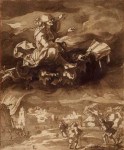Temptresses, sirens, she-devils, Weird Sisters and harpies: nothing stirs the religious, social and sexual anxieties of civilisation like the supernatural feminine form. No surprise, then, that women and magic have been twinned for centuries in art, literature and folklore, and often in the eyes of the law and the Church (with violent and oppressive consequences). Aptly coinciding with Halloween, the British Museum’s exhibition ‘Witches and Wicked Bodies’ tells the story of the Witch in her ever-changing manifestations. The display features drawings, engravings, paintings and ceramics from the museum’s own collection, as well as loans from the Victoria & Albert Museum, the Ashmolean, Tate Britain and the British Library.
Older artefacts such as Greek urns depicting the myth of Medea – the vengeful wife of Jason who commits double infanticide when betrayed – hint at the beginnings of the trope of the powerful female as grotesque, and unnatural. But it is the Christian era, when such characters began to inundate Western imagery and literature, that forms the focus of this show. Fantastically detailed Renaissance engravings of malevolent seductresses, moustached and muscular hags, and dark forests or equally sinister kitchen hearths, show how evil took feminine form in the collective European imagination.
Although the classical sorceresses Medea and Circe continue to feature, they are overshadowed by fantastical depictions of nudes dancing among bats and cats, or riding through the night on goats and skeletal horses. Hans Baldung’s Witches’ Sabbath from 1510, a woodcut of witches concocting a potion, might reflect male suspicion of that site of female bonding, the domestic hearth. It’s also a remarkable education in the sorts of animal features and behaviours that were deemed to ‘mark out’ a witch. In a similar scene, Jan Van Der Velde’s engraving The Sorceress (1626), features another spell-making night: our witch here is young, nymph-like and virginal, but devilish spirits crowd around her fire nonetheless. Witches could embody every sin and vice: depictions of them served as a warning against social, sexual and religious deviance, but they were also vessels for precisely those fantasies of transgression.
They spin finely (Hilan Delgado) (1799; Los Caprichos, plate 43), Francisco de Goya y Lucientes © The Trustees of the British Museum

Goya’s etchings of hideous hags with masculine torsos and hanging breasts are the most psychologically thrilling exhibits. In the 18th and 19th century sections, depictions of witches from literature – such as Henry Fuseli’s Weird Sisters from Macbeth and Goethe’s Faust as illustrated by Eugène Delacroix – take centre stage. By the end of the 19th century Romantics and Symbolists took up the subject: Dante Gabriel Rossetti’s mysterious, aloof Lilith (1868) and Odilon Redon’s dark, solitary females are on show, and the figure of Joan of Arc emerges as a new representation of a subversive, and therefore dangerous, women.
Taking the visitor on a journey from the macabre and obscenely lewd imagination of the Elizabethans to the sinister mistrust of the mysterious female ‘other’ in more recent centuries, ‘Witches and Wicked Bodies’ is one to see for its well-curated selection of works, and one to think on for its insights into man’s age-old anxieties.
‘Witches and Wicked Bodies’ is at the British Museum, London, until 11 January 2015.
Related Articles:
Review: The British Library goes Gothic (Danielle Thom)
First Look: ‘Sympathy for the Devil’ at the Cantor Arts Center (Bernard Barryte)





